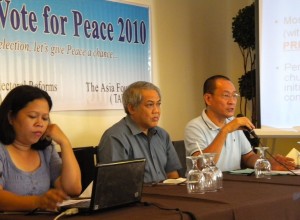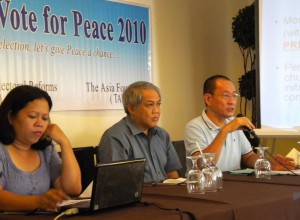By LUZ RIMBAN
 THE Commission on Elections is partly to blame for election-related violent incidents because it acted too late to put critical areas, including the Autonomous Region in Muslim Mindanao (ARMM), under its control, said an election watchdog group.
THE Commission on Elections is partly to blame for election-related violent incidents because it acted too late to put critical areas, including the Autonomous Region in Muslim Mindanao (ARMM), under its control, said an election watchdog group.
The Consortium on Electoral Reform (CER) said the Comelec ran out of time to implement Resolution 8887, which was issued only on May 8, just two days before the elections.
The Resolution creates special task forces composed of police, military and Comelec officials to contain violence in the whole of ARMM, as well as the provinces of Nueva Ecija and Abra, and several other towns. But because it was issued at the eleventh hour, there was no time to send more military or police forces to these critical areas, especially to the ARMM.
As it turned out, the ARMM had the most number of election-related violent incidents during the 2010 election period, said the CER, which implemented the project Vote Peace.
Vote Peace monitored election-related violence and recorded 130 incidents from January 10 until May 13. Of this number, 22 percent took place in ARMM.
The most volatile area was Lanao del Sur where Vote Peace recorded the most number of victims and incidents, which ranged from shooting clashes to strafings and bombings.
“Had the Comelec declared the province under its control much earlier, the political environment in the area may have been different,” Vote Peace said.
The 2010 elections actually saw election-related violent incidents (ERVIs) drop to their lowest level in 12 years, but there were more deaths, the killings have become more sophisticated, and the operations and targets more precise.
This paradox was part of the “new face of election violence,” Vote Peace said.
Counting from January 10, the start of the election period, up to election day, Vote Peace recorded 119 ERVIs. Records of the Philippine National Police show 267 incidents for the same period in 1998. But the number of fatalities was higher this year at 94, compared to only 87 in 1998.
Vote Peace said the drop in violent incidents could be attributed to the “notable peace” in traditional election hotposts—Abra, Nueva Ecija, Masbate, Samar, Lanao del Norte and Sulu—which became the backdrop of previous election violence.
But violence erupted in new election flashpoints like Zamboanga Sibugay, Lanao del Sur, and provinces in Southern Luzon and Western Visayas.
The group singled out the Comelec as the least involved in efforts to reduce ERVIs among the various stakeholders—the Catholic Church, the military, the police and civil society.
But Vote Peace said Comelec’s performance on ERVIs was dismal, mainly because it was too absorbed with the automation process. “Halos walang naging papel ang Comelec (Comelec had almost no involvement),” said Vote Peace project coordinator Patrick Patiño.
Patiño said most of the ERVIs in this election were premeditated attacks with specific targets, such as assassinations, ambushes and shootings.
“Most of the casualties were those directly related to the campaign such as candidates, campaign operators, key supporters, campaign managers and key staff,” Patiño said. There were fewer accidental victims this year, compared to previous elections.
This gave rise to the initial assessment, Patiño said, that most of those responsible for the violence were hired killers or professional armed groups. The attacks were mostly perpetrated by “unidentified motorcycle riding armed men,” not known to locals and unidentifiable, hence the difficulty of bringing the cases to court.
Vote Peace monitoring also showed that weapons used in this election were usually .45 caliber pistols or 9 mm guns, rather than the armalites that caused more casualties.
Vote Peace credited the joint efforts of the Church, the military, the police and civil society for the reduced number of ERVIs. An alliancce among these stakeholders in various provinces resulted in the signing of peace covenants that bound politicians to the cause of peaceful elections. This efforts were most pronounced in the traditional hotspots where the various stakeholders worked together to prevent a repeat of the violence seen in elections past.
